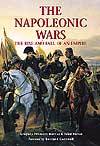Book
Review:
The Napoleonic Wars:
The Rise and Fall of an Empire
By
Gregory Fremont-Barnes and Todd Fisher
 If
you are looking for something that can explain the remarkable
career of Napoleon Bonaparte and major aspects of the Napoleonic
Wars in an easy to read way then we obviously have to recommend
The Napoleonic Guide.
If
you are looking for something that can explain the remarkable
career of Napoleon Bonaparte and major aspects of the Napoleonic
Wars in an easy to read way then we obviously have to recommend
The Napoleonic Guide.
But
if you are after a book that can do the same then one we can suggest
looking at is a new title from Osprey called The Napoleonic Wars:
The Rise and Fall of an Empire.
In
352 pages the authors Gregory Fremont-Barnes and Todd Fisher have
encapsulated the period exceptionally well and boost the information
with top-notch graphics and maps and some very high-resolution
images.
The
book begins with a short introduction and a chronology of the
wars before getting into the various phases of the conflict. (I
believe each of these were individual books that have now been
combined into one volume so check you don't already have them.)
The
first is titled The Rise of the Emperor 1805-1807 and this covers
the period from the Treaty of Amiens onwards to 1808.
It
examines that phoney peace, each of the opponents, the preparations
for renewed war, Ulm and the treaty of Tilsit. There are also
very fine biographies in these sections and the first includes
Jean Lannes and a musician at war, Philippe-Rene Girault.
The
second time period covered is 1808 to 1812 and is called The Empires
Fight Back.
The
authors background the move towards war, the French, Austrian
and Russian armies, the 1809 campaign and France's invasion of
Russia in 1812. They finish with a look at a French emperor very
much under pressure.
The
portrait/biographies in this section are the soldiers Barclay
de Tolly and Jacob Walter, and a civilian Louise Fusil.
Part
three centres on The Peninsular War 1807-1814 and begins with
the relationships of the perennial foes Britain, FRance and Spain.
The armies are examined, how the Peninsular War broke out, the
battles between regular armies and how it was a very different
war with civilians fighting back savagely against a brutal military
machine.
It
finishes in 1814 with the campaign of 1814.
Those
people highlighted are Prviate Edward Costello, a rifleman in
the 95th, and Britain's Foreign Secretary George Canning.
The
final period of the book is The Fall of the French Empire 1813-1815.
It looks at the enmity the Russians and Prussians had for Napoleon,
looks at the opposing armies, the War of German Liberation and
the invasion of France. As you would expect it finishes, along
with Napoleon's career, at Waterloo.
Captain
Cavalie Mercer of the Royal Horse Artillery and Lord Castlereagh
are the biographies.
Art
in the Empire gets a chapter to itself and while French and Austrian
society and culture get concise mentions, most of the chapter
is dedicated to Spain's Francisco de Goya and his stunning Disasters
of War series.
Finally
there is a 17-page wrap-up of the Revolutionary and Napoleonic
Wars and what happened to world society's after the fall of Napoleon.
I
found The Napoleonic Wars: The Rise and Fall of an Empire to be
very hard to put down. The information within its pages was well
written and interesting and there are hundreds of images that
bring to life the colour and flavour of the period. And there
are scores of short biographies and portraits of well-known and
not-so-well-known figures.
The
image quality is superb - although
I do have one complaint. When will people learn not to put lovely
pictures across two pages? I want to see the engraving, painting
or sketch in its entirety - and not have it split by the page
fold. Just make them smaller.
-
Richard Moore
9.5/10
Osprey
Website
Osprey
PO Box 140,
Wellingborough,
Northants,
NN8 2FA,
UK.